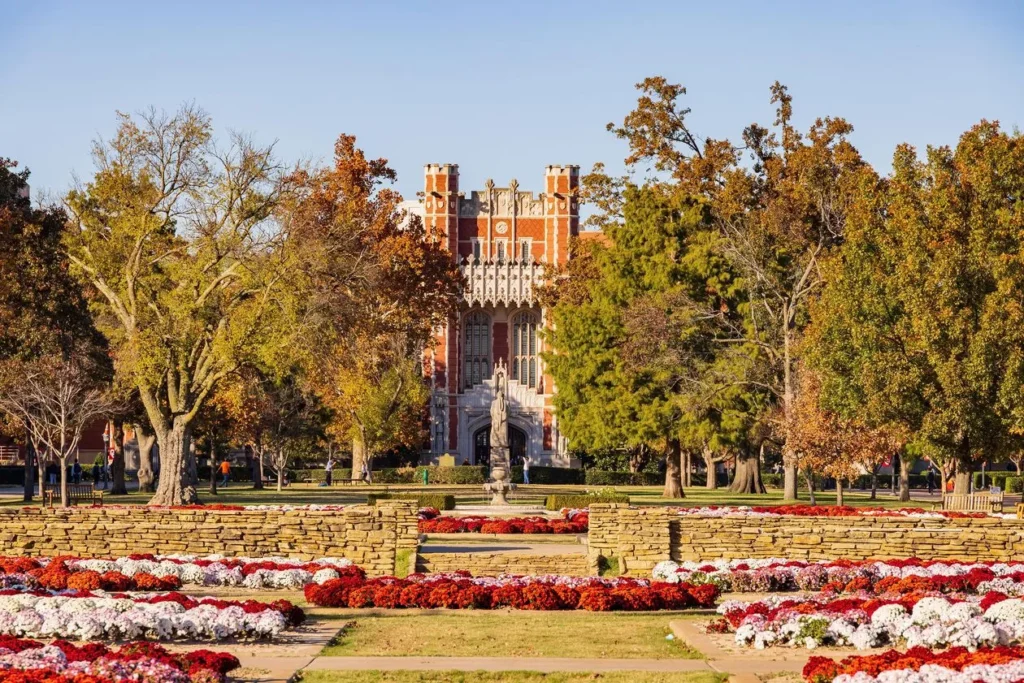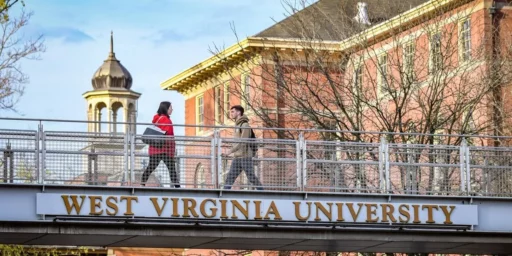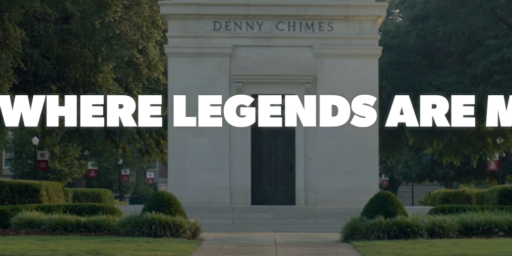Flagship University Arms Race
The oldest state institutions of higher education are spending money to make money.

A WSJ report titled “Colleges Spend Like There’s No Tomorrow. ‘These Places Are Just Devouring Money.’” with the subhead “Students foot the bill for flagship state universities that pour money into new buildings and programs with little pushback.” While the headline claim is arguably true, the follow-on claim mostly isn’t.
The nation’s best-known public universities have been on an unfettered spending spree. Over the past two decades, they erected new skylines comprising snazzy academic buildings and dorms. They poured money into big-time sports programs and hired layers of administrators.
Then they passed the bill along to students.
The University of Kentucky upgraded its campus to the tune of $805,000 a day for more than a decade. Its freshmen, who come from one of America’s poorest states, paid an average $18,693 to attend in 2021-22.
Pennsylvania State University spent so much money that it now has a budget crisis—even though it’s among the most expensive public universities in the U.S.
The University of Oklahoma hit students with some of the biggest tuition increases, while spending millions on projects including acquiring and renovating a 32,000-square-foot Italian monastery for its study-abroad program.
The spending is inextricably tied to the nation’s $1.6 trillion federal student debt crisis. Colleges have paid for their sprees in part by raising tuition prices, leaving many students with few options but to take on more debt. That means student loans served as easy financing for university projects.
“Students do not have the resources right now to continue to foot the bill for all of the things that the university wants to do,” said Crispin South, a 2023 Oklahoma graduate. “You can’t just continue to raise revenue by turning to students.”
So, as noted here many times, there has been something of an arms race among public universities to upgrade facilities. And, yes, this results in tuition increases and greater loan burdens. But it’s way more complicated than that.
It has long been clear to American families that the cost of college has gone up, even at public schools designed to be affordable for state residents. To get at the root cause, The Wall Street Journal examined financial statements since 2002 from 50 universities known as flagships, typically the oldest public school in each state, and adjusted for inflation.
At the median flagship university, spending rose 38% between 2002 and 2022.
Only one school in the Journal’s analysis—the University of Idaho—spent less.
The schools paid for it in part by pulling in tuition dollars. The median flagship received more than double the revenue from undergraduate and graduate tuition and fees it did 20 years prior. Even accounting for enrollment gains, that amounted to a 64% price increase for the average student, far outpacing the growth in most big household expenses.
Honestly, I’m surprised that the median increase is only 38% over those two decades.
Public university leaders often blame stingier state funding for the need to raise tuition revenue. And three-fourths of states did cut their support, undermining a longstanding principle that schools educated the populace with government backing. But universities generally didn’t tighten their belts as a result. Rather, they raised prices far beyond what was needed to fill the hole.
For every $1 lost in state support at those universities over the two decades, the median school increased tuition and fee revenue by nearly $2.40, more than covering the cuts, the Journal found.
But this is explained by manifold factors.
Through it all, schools operated in a culture that valued unrelenting growth and prioritized raising revenue over cutting costs. Administrators established ambitious strategic plans and tried to lure wealthy students with luxurious amenities. Influential college rankings rewarded those that spent more.
Many university officials struggled to understand their own budgets and simply increased spending every year. Trustees demanded little accountability and often rubber-stamped what came before them. And schools inconsistently disclose what they spend, making it nearly impossible for the public to review how their tuition and tax dollars are being used.
“These places are just devouring money,” said Holden Thorp, who was chancellor at the University of North Carolina at Chapel Hill from 2008 to 2013 and is now editor in chief of Science. Offering everything to everyone all at once is unsustainable, he said. “Universities need to focus on what their true priorities are and what they were created to do,” he said.
Colleges invested money inside and outside the classroom, including to improve technology, expand counseling and intramural sports, and build facilities such as modern dorms and new stadiums.
As we’ve discussed numerous times before, these schools compete with one another—and with private universities—to attract the best students, the best faculty, and to field the best athletic teams. And this means investing in facilities. Students want dorms that come closer to a resort than a barracks. They want dining halls and food courts with lots of high-quality options. Schools that don’t provide these will lose out to those who do.
The University of Florida in 2022 had more than 50 employees with titles of director, associate director or assistant director of communications, roughly double the number it had in 2017. The school also employed more than 160 assistant, associate, executive and other types of deans last year, up from about 130 in 2017.
My co-blogger Steven Taylor can speak to this with more knowledge than me but my understanding that most of this is a function of complying with ever-increasing regulations. And some of it is an ever-increasing staff for marketing and fundraising.
Spokesman Steve Orlando said the university is decentralized and different departments have the freedom to hire as they need.
Inflation-adjusted spending on athletic coaches rose by about half between 2010 and 2022 at the median flagship, the Journal’s analysis of data from the Knight-Newhouse College Athletics Database found. The Journal used data from the period with the most complete figures.
Though a handful of powerhouse sports departments pay for themselves, most can break even only with student fees and university subsidies.
Across all flagships with available data, that additional funding totaled $632 million in 2022. That’s a jump of 27% from 12 years prior.
The University of Connecticut won the national championship this spring in men’s basketball, and its women’s team has been a near-constant presence in the Final Four. Yet since 2016, Connecticut’s athletic department has received more than $35 million annually in student fees and university subsidies to stay afloat. In 2022, it took in $55 million in such funds, making up more than half its total athletics budget.
The school said more than $13 million of that subsidy covered a payout to a former men’s basketball coach as part of a legal settlement over his employment contract, and that it faces unique challenges in having to pay rent and other fees for basketball and hockey games, which are played off campus.
Overall, the University of Connecticut’s spending rose by 73% between 2002 and 2022, far faster than enrollment grew. Much of that was driven by personnel costs, with spending on benefits more than tripling.
UConn seems to be an extreme outlier, though. The flagship campus charges a reasonable $16,332 in tuition for in-state students but adds a whopping $4034 in non-waivable student fees. That’s a lot. My graduate alma mater, The University of Alabama, charges $11,100 in tuition for in-state students and only $800 in student fees. Certainly, it’s investing massively in facilities and athletics.
Indeed,
Overall, the University of Connecticut’s spending rose by 73% between 2002 and 2022, far faster than enrollment grew. Much of that was driven by personnel costs, with spending on benefits more than tripling.
Reka Wrynn, associate vice president of budget, planning and institutional research, said that was in part because the school was on the hook for a growing share of the state’s unfunded pension liability. Connecticut was also obligated to pay for raises that unionized employees negotiated with the state, she said.
Honestly, UConn seems to have been cherry-picked precisely because it’s an outlier.
Again, there’s simply no doubt that schools, and especially flagships and others competing for national prestige, are spending a lot of money to do so. The WSJ article is festooned with photos of lavish student centers, dorms, and outdoor beautification projects. I’ve visited the Alabama campus a couple of times in the past year after not having been there in two decades. It’s a radically nicer campus than it was when I was a student in the 1990s.
But, no, all of the spending isn’t coming on the backs of students. Even small universities like my undergraduate alma mater and the one Steven and I taught at and where he’s now a dean, have constant capital campaigns to raise huge amounts of money from alumni and local businesses. And athletics, especially, is a huge component of this because it keeps graduates and the community connected to the school in a way that faded memories of the classroom experience simply don’t.
Two years ago, my post “Alabama, Disney, and the Quest to Be a National University” looked in detail at how this all played out at my graduate alma mater. It’s a fascinating case, really. There was a long-term plan to ratchet up the quality, size, and ability to pay of the student body that has worked spectacularly. There are a third more students than there were two decades ago and they have markedly higher SAT scores. A much higher percentage come from out-of-state and thus pay triple the tuition.
This moved the university up the US News rankings. But it also changed the very nature of the school from a national university rather than one that primarily educates the best and brightest students from the state after which it’s named.






As a parent that has pushed three children through state college in the last 10 years, I have found the real cost is in room and board and living expenses. The youngest went to UT-Austin where the price of housing is sky high on or off campus. There is no cheap housing, no student slums anywhere.
The article is just talking about state universities as if bashing them is the point. It doesn’t explain the explosion in costs at private colleges and universities. Are they spending out of control also? Do they have layers and layers of administrator and luxury campuses also?
One suspects the purpose of the article is to lay suspicion and blame for student debt in order to push back on any student debt relief. In fact my congresscritter, Chip Roy has made this proposal:
Chip Roy is reviving a Ron DeSantis bill to make schools pay for bad student loans
This makes as much sense as Ford being responsible for someone defaulting on a vehicle because they encouraged the buyer to buy a luxury car instead of practical transportation.
Hi:
An inflation increase of 2% per year, over 20 years, yields a 48% increase in costs over those two decades, which is higher than the increase in this article. Shouldn’t we be asking why the price increase hasn’t been larger?
Ron
While I can’t speak for the other schools mentioned, I can speak for Penn State:
The reason Penn State is the mostly costly of the 50 flagship universities not because it’s spending is out of line, but rather because it is also the lowest funded of the 50 flagship universities. And it’s budget issue is the result of a gerrymandered republican legislature that has for a decade now been cutting state education funding while requiring tuition freezes at state funded schools.
As one might expect from the source, this is WSJ propaganda trying to cover up Republican misgovernment and blame the predictable results thereof on the victims rather than the politicians responsible.
You know, given the source (WSJ) and that lede, I would have ignored this piece as a propaganda hit piece. I hits me like an “old man yells at clouds” kind of article.
One could look at what happened and say that universities have managed to upgrade and grow even in a climate (Covid and the Great Recession) that maybe wasn’t all that favorable to the economy in general. Particularly with Ron’s observation above comparing rate hikes with inflation.
@Stormy Dragon:
Edit: I suppose that should be “speak about” rather than “speak for” ;P
I agree with JJ — the expenses aren’t coming on the backs of students. They’re coming on the backs of faculty.
Across academia there has been a huge transfer of resources from the people who actually do the teaching to those who take care of the business. Fewer and fewer classes are taught by an increasing rare breed of tenured faculty and more my wildly underpaid and poorly treated adjuncts.
Which is also what’s happening in the OTHER field I work in, the entertainment industry. Where writers are on strike because there has been a steady transfer of resources (including creative authority) from those actually hired to create to those who work in the corporate structure.
Corporate America — and unfortunately, that now includes vast swaths of academia, thanks to regents and overseers and other controlling boards who come from Wall Street and not education — is working hard to turn every job other than corporate vice-president into one more scrap in the gig economy. Workers who were once considered indispensable to the institution’s core mission are now seen as replaceable cogs who should be switched out as frequently as possible so that they don’t start to feel entitled to decent treatment.
America is becoming one great Amazon warehouse, and academia is just the latest front in the war of corporations versus workers.
What strikes. me is that the only school which decreased costs also had a decrease in enrollment. Maybe since they aren’t improving the school they are losing students? Regardless, it does look like tuition is growing ahead of inflation. I think the 38% number accounts for inflation. A big chunk of that is due to losing govt funds. Administrative costs have clearly grown. I don’t know how much of that is due to regulations and how much is schools trying to appeal to customers ie parents/students.
However, if the school is growing as opposed to having a static population that has to give you big capital costs that you would not see without an expanded number of students. The money for those capital costs haver to come from somewhere.
Steve
The elephant in the room is the amount of money available for students to pay thanks to easy student loan terms. There aren’t many incentives to keep tuition or costs down when schools know students can borrow more, often more than they can afford or pay back. And canceling student debt without reforming the system is just another subsidy and incentive for schools not to control costs.
I think WR’s point is also a big factor – like so many other areas, costs have risen because of ever-increasing administration and bureaucracy which also moves institutions away from their core goals of education.
And the whole thing about funding college sports is just another data point about how immoral the whole system is. You’ve got lots of people making a shit-ton of money off of college sports on the backs of “amateur” athletes and student-paid subsidies on the majority of schools whose sports programs can’t stand on their own. The priorities are completely backward.
Well, I guess I now know where the money that kept me swinging a hammer the last 1o years I worked came from.
“Students want dorms that come closer to a resort than a barracks. They want dining halls and food courts with lots of high-quality options. Schools that don’t provide these will lose out to those who do.”
And then they graduate and complain about their debt load.
Our student loan structure basically says, “Here… take all the money you want and need.” And we wonder why everything just keeps going up and up and up.
ETA: I see Andy made my point far better than I did!
It’s only a real arms race if Yale start commissioning Dreadnoughts, and threaten to cut Harvard off from its vital supplies of iron ore…
🙂
After all, surely you need a battleship to be a flagship university?
@wr:
I had not thought about it that way, but it’s a perfect description.
Are we going to be talking about the fires on Maui? I would think that the destruction of Lahaina by a climate change-driven inferno would rate a few posts.
I have lots of thoughts, but am guessing this thread is probably done, so will save them for another day.
@Steven L. Taylor:
We would be very interested to hear them.